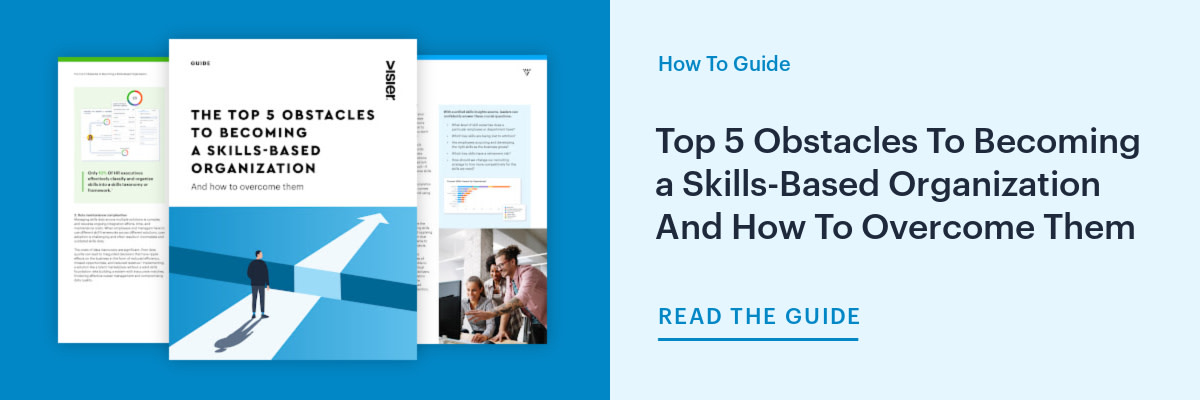Talent Intelligence: A Comprehensive Guide
Talent intelligence provides valuable insights into internal and external workforce trends, resulting in a competitive edge and improved hiring. Learn more.

Talent is the backbone of an organization. You can have the best ideas and the perfect business plan, but if you don’t have the right talent to help bring those ideas to light, it could all be in vain. The Great Resignation, the pandemic, and a potential recession, all are changing how employees approach work. Talent intelligence can help identify and retain top talent, and bridge the skills gaps that may appear from time to time.
Here’s everything you need to know about it.
What is talent intelligence?
Talent intelligence is a process where companies collect and analyze data related to both internal and external talent (i.e. data about the company’s competition and industry). It looks at trends in the job market and the company’s current and future skill needs to find a competitive edge and improve hiring success.
Talent intelligence is a relatively new concept, so people might have different views on its usage. One thing is certain, though. You need more than internal data. Talent intelligence can only be successful if you look at external data as well, benchmarking against the competition.
The primary goal of talent intelligence is to help companies make data-informed talent acquisition and management decisions. Let’s think for a second about talent acquisition. Every company can agree it isn’t a simple process. There are a lot of variables to consider.
And when you finally hire someone, you expect the time to productivity to be short. But what if it isn’t? What if it turns out the person is not as great a fit as you thought they would be? Or what if you realize there are still many skill gaps left uncovered?
You can avoid these situations by relying on talent intelligence. It can help you carefully plan your future skill needs, identify and attract the best people for the job, and later increase retention.
What is the difference between talent intelligence and people analytics?
If you’ve ever been confused about the difference between talent intelligence and people analytics, don’t worry, you’re not alone! Both can help improve your talent acquisition process and your retention rates, and they both come with a data-driven approach. Despite the similarities that you’ll see on the surface, they’re different.
Talent intelligence focuses strictly on data that revolves around skills, knowledge, and people’s abilities. It looks at both your existing employees, but especially at the competition and the market in general. In short, talent intelligence gives you the insights you need to navigate a market where the need for talent outweighs the existing talent.
People analytics takes a broader look at data focusing on the entire employee lifecycle. It seeks to understand what factors drive things like performance, engagement, productivity, or attrition. By looking at this data, companies can make decisions regarding talent management, workforce planning, or organizational design.
They are amazing tools on their own, but their true power comes when you combine them because they can help you better understand the entire talent chain. You’ll get a clear view of the market and the existing talent and what people are looking for, but also what skills you need, and what your workforce is currently offering at various stages.

Benefits of talent intelligence
Finding the right talent is a complex process. There certainly is no one-size-fits-all solution. There is often a lot of trial and error, and learning from your mistakes. Talent intelligence can help ease that process and might even help you learn without making so many mistakes. Here’s how it can help.
1. Understand the labor market trends
The labor market has never been more volatile than it is today. Emerging technologies and external factors like pandemics and recessions are creating unprecedented shifts.
To stay ahead and find the right people for your company, you need an in-depth understanding of these trends. Talent intelligence helps you see where the labor market is heading, what drives employees to resign, or what makes them choose one company over another.
2. Create personalized hiring criteria
Creating a job ad and looking for people with only a handful of skills to fill that one position is a strategy that can sometimes backfire. There's more to a person that a specific set of skills, and it’s likely that your company also needs more skills.
The right fit for a job, after all, is not only someone who can do the work, but also someone who aligns with the company’s values and goals and can grow with it.
Talent intelligence gives you a detailed perspective of the company’s current and future talent needs and the market, and it helps you align this data with other aspects, such as behavioral patterns, core values, and future goals. You’ll be able to personalize the hiring criteria so that the person you hire will be a good fit in every way.
3. Reduce turnover rates
Voluntary attrition is one of a company’s worst nightmares. You’re losing valuable talent and you often have no idea why.
People might leave because they’re moving to a different city, because they want to try something new that your company can’t offer, or simply to retire. But they shouldn’t have to leave because they don’t feel respected or because of poor management.
Talent intelligence helps you look closer at internal mobility and various HR metrics, allowing you to understand why people leave and what you can do about it.
4. Improve diversity, inclusion, and equity programs
More and more employees want to work in companies that prioritize diversity and inclusion. Talent intelligence can help you analyze workforce demographics to identify diversity gaps. It will also help you remove bias in recruitment. This bias is often unintentional and can go unnoticed for years.
An example is a job ad that has gendered language and that could make some people feel like they’re not welcome to apply. Recruiters may also sometimes have stereotypes in mind when conducting interviews that could impact their decisions.
Talent intelligence can help you analyze job descriptions to make sure the language is inclusive or to create standardized procedures for interviews to ensure personal biases will not affect a candidate’s chances.
5 ways to get started with talent intelligence
A talent intelligence platform can come with incredible benefits for your company when used correctly. But without a solid strategy to support it, the effectiveness of the platform will be limited. Here are a few steps to take before you can put your talent intelligence program to work.
1. Define your goals
You need to know where you’re going if you want to get there. That stands true for any goals you set, and talent intelligence is no different.
Identify the challenges you’re currently facing regarding talent, the opportunities you’re seeking, and where you eventually want to be. Choose the key performance indicators (KPIs) you’ll be measuring along the way to get a clear view of what progress should look like.
2. Identify your skill needs
Talent and skills go hand in hand. Before you can start thinking about collecting and analyzing data, you need to identify your skill needs. Leverage a skills intelligence solution to glean critical skills insights to understand the current skills in your organization. You must be able to answer questions like:
What skills does the organization have?
What skills are missing?
How have the skills in our organization changed?
Once you have a solid understanding of your skills foundation, you can identify and plan for skill gaps in your organization. Conducting a skills gap analysis will also be useful and will help you map out your skill requirements.

3. Collect and organize data
Once you know your goals, the next step is to collect the data and create a talent database. Look at both internal and external data. The power of talent intelligence lies in the fact that it allows you to get an in-depth look at the labor market beyond the people that are already in your company. That way, you can have a better grasp of existing talent and even predict talent and hiring trends.
Pro tip: Use a platform that has a built-in global jobs and skills ontology that automatically captures and standardizes skills data.
4. Data analysis
You have the goals, the skill needs, and the data. It is time to dive into the steps you’ve been waiting for—analysis. Look for patterns, gaps, and opportunities. You can use data visualization tools, statistical analysis, and any other tools and methods you feel will be useful.
You can also use this moment to conduct an industry analysis. You’ll be surprised at how much you can uncover. What are the hiring best practices at the moment? How long do your competitors take to hire for various roles? What did your employees do after they left the company? What skills are your competitors looking for the most?
These are only some questions you can ask that will allow you to better understand the labor market, see what sets you apart from your competitors, and where you could and should improve.
5. Monitor and adjust your strategy
Talent intelligence will be part of your ongoing business strategy. That’s why it will require constant improvement. After all, the labor market is constantly changing, so your talent intelligence solution needs to be flexible as well.
Assess your progress, your goals, and your data sources periodically. Make sure everything is still relevant to your current business direction and to the social and economic realities and adapt accordingly.
Talent intelligence is the perfect tool if you’re looking to make data-informed decisions about your talent management strategies. Together with people analytics, talent intelligence will give you powerful insights about the labor market, any existing skill gaps, issues that may lead employees to quit your company, and more.

On the Outsmart blog, we write about workforce-related topics like what makes a good manager, how to reduce employee turnover, and reskilling employees. We also report on trending topics like ESG and EU CSRD requirements and preparing for a recession, and advise on HR best practices like how to create a strategic compensation strategy, metrics every CHRO should track, and connecting people data to business data. But if you really want to know the bread and butter of Visier, read our post about the benefits of people analytics.


